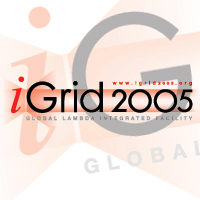iGRID 2005 :: CALL FOR PARTICIPATION
September 26th, 2005 - September 30th, 2005
Categories: Applications, Devices, Networking, Visualization

About
iGRID 2005
EVENT DATES AND LOCATION
California Institute for Telecommunications and Information Technology [Cal-(IT)2]
University of California, San Diego
iGrid Workshop: 26-29 September 2005
GLIF Meeting: 30 September 2005
iGrid 2005 CALL FOR PARTICIPATION
For full consideration, PROPOSALS ARE DUE 1 FEBRUARY 2005
Submit to Maxine Brown > maxine @ uic.edu.
See details below or Click on the iGRID 2005 link above.
SHOWCASING THE GLOBAL LAMBDA INTEGRATED FACILITY
A global cyberinfrastructure of computing and communication technologies is emerging to help researchers better understand complex systems - from the micro to the macro level, in both time and space. Driven by the demands of application scientists, engineered by a worldwide collaboration of leaders in advanced networking, and enabled by grid middleware developers, this infrastructure has, at its core, new architectural approaches to next-generation internet design and development using optical networking. A single optical fiber can carry multiple wavelengths of light, or “lambdas,” enabling multiple networks to run in parallel on the same fiber - research & education networks, commodity networks, or application-specific networks. Communities of interest can create their own private networks or can share networks, creating on-demand “LambdaGrids” of interconnected, distributed computing, sensor and instrument resources that enable new infrastructures for advanced science.
The Global Lambda Integrated Facility (GLIF) is an international virtual organization that supports persistent data-intensive scientific research and middleware development on LambdaGrids. This year’s iGrid (international Grid) event will showcase advances in scientific collaboration and discovery enabled by GLIF, by providing a forum for the world’s premier discipline scientists, computer scientists and network engineers to work together in multidisciplinary teams to understand, develop and demonstrate innovative solutions in a LambdaGrid world.
iGrid 2005 is a coordinated effort to accelerate the use of existing multi-10 Gbps international and national networks, to advance scientific research, and to educate decision makers, academicians and industry researchers on the benefits of these hybrid networks. iGrid 2005 provides an international testbed for participants to collaborate on a global scale to advance the state of the art in high-performance computing and communications.
iGrid 2005 organizers challenge the international research community to demonstrate application advances and middleware innovations developed for the LambdaGrid. iGrid 2005 welcomes your participation to showcase novel techniques for problem solving enabled by GLIF. You may propose to do a real-time demonstration or presentation or participate in one of three “challenges.” To participate, you must submit a proposal of your intended activities (proposal requirements are described below) by February 1, 2005 for full consideration. You will be notified of acceptance by mid-March.
CALL FOR REAL-TIME DEMONSTRATIONS AND SYMPOSIUM PRESENTATIONS
REAL-TIME DEMONSTRATIONS will provide “windows” into the worldwide LambdaGrid. Scientists who generate terabytes and petabytes of data on remote computers or instruments can demonstrate how they use the LambdaGrid to interactively visualize, analyze, and correlate data from multiple sites; results will be projected onto large visualization and/or virtual-reality displays. Previous iGrid events featured applications in art, bioinformatics, chemistry, cosmology, cultural heritage, education, manufacturing, medicine, geoscience, neuroscience and physics. They featured a variety of Grid middleware developments, with emphasis on data management grids, data replication grids, visualization grids, data / visualization grids, computational grids, access grids, and grid portals. And, they utilized a variety of computer-based technologies, including distributed computing, visualization and virtual reality, tele-science, data mining, remote instrumentation control, collaboration, high-definition media streaming, and human / computer interfaces.
SYMPOSIUM PRESENTATIONS complement the demonstrations. Tutorials, workshops, keynote presentations, and lectures by renowned scientists and technologists about GLIF activities, optical networking and control plane management, middleware developments and application advances, will provide attendees with an in-depth understanding of today’s emerging global cyberinfrastructure so that they can incorporate these new technologies into their future plans.
CHALLENGES have been part of all previous iGrid events. iGrid challenges the world’s scientists and technologists to advance the state of the art, while providing the infrastructure and the expertise to assist. For 2005, we pose the following challenges to the international community.
- TERABIT LOCAL AREA NETWORKS (LANs): While scientists are learning to optimally use wide-area gigabit networks, there is interest in developing multi-terabit networks by first prototyping them on a local scale. Who wants to help design a Terabit LAN, and who has data-intensive applications that need it?
- SUPER-HIGH-DEFINITION (SHD) DIGITAL CINEMA: Four times the resolution of HDTV, SHD projection technology is emerging from the research laboratory. Who has high-resolution computer-generated imagery to show, and who is developing the tools and techniques for secure streaming media?
- HIGH-RESOLUTION VIRTUAL REALITY: A large-format autostereo tiled display and possibly a 6-wall CAVE will be available. Who has high-resolution three-dimensional computer-generated imagery to show?
Let us know if you are interested in any of these challenges and we will put you in touch with others who are working on these problems for iGrid 2005.
All participants will have the opportunity to submit an article to the Elsevier journal “Future Generation Computer Systems” (FGCS); the editor-in-chief has agreed to publish a special iGrid 2005 issue. Papers should describe research activities and findings, and are due one month after iGrid 2005 to ensure timely publication.